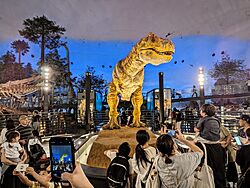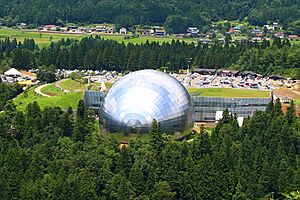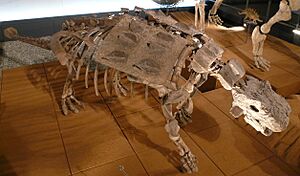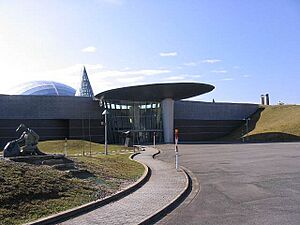Fukui Prefectural Dinosaur Museum facts for kids
 |
|
| Lua error in Module:Location_map at line 420: attempt to index field 'wikibase' (a nil value). | |
| Established | July 14, 2000 |
|---|---|
| Location | 51-11 Terao, Muroko-chō, Katsuyama, Fukui Prefecture, Japan |
| Type | Natural history museum |
| Visitors | 901,119 (FY2016) |
| Architect | Kisho Kurokawa |
| Public transit access | Katsuyama Eiheiji Line (Echizen Railway) |
The Fukui Prefectural Dinosaur Museum (福井県立恐竜博物館 (Fukui Ken-ritsu Kyōryū Hakubutsukan)) is a super cool place in Katsuyama, Fukui, Japan. It's one of the best dinosaur museums in Asia! This museum is famous for showing off amazing dinosaur fossils and for the important research scientists do there.
The museum is located in Nagaoyama Park, also known as the Katsuyama Dinosaur Forest Park. It's very close to a special spot called the Kitadani Dinosaur Quarry. This quarry is where many dinosaur bones have been found. Some of these include famous dinosaurs like Fukuiraptor kitadaniensis and Fukuisaurus tetoriensis.
Since 2009, the entire area of Katsuyama City has been recognized as a Japanese Geopark. It's called the "Dinosaur Valley Fukui Katsuyama Geopark." Since 2014, you can even take guided tours to a field station near the actual dinosaur dig site! This is usually open from late April to early November.
Dozens of fossil bones from five different dinosaurs, along with their excavation site, have been named a Natural Monument of Japan since 2017. The main office for the Asia Dinosaur Association has also been located inside the museum since it started in 2013.
Contents
Museum History and Discoveries
The Fukui Prefectural Dinosaur Museum (FPDM) opened its doors in 2000. It was built in Nagaoyama Park, which is very close to where dinosaur fossils are found. The museum focuses on paleontology (the study of fossils) and geology (the study of Earth's rocks and history).
Here are some important moments in the museum's history and dinosaur discoveries:
- 1982: A nearly complete skeleton of a crocodile-like animal was found in Katsuyama City.
- 1988: Two teeth from a meat-eating dinosaur were discovered at the same site as the crocodile skeleton.
- 1989-1993: The first big dinosaur excavation project took place for five years.
- 1995-1999: A second major dinosaur digging project happened for another five years.
- 2000: The museum building was finished in June.
- 2000: The dinosaur Fukuiraptor kitadaniensis was officially named.
- 2000: The Fukui Prefectural Dinosaur Museum officially opened on July 14.
- 2003: The dinosaur Fukuisaurus tetoriensis was named.
- 2007-2010: The third dinosaur excavation project was carried out.
- 2010: The dinosaur Fukuititan nipponensis was named.
- 2013: The Asia Dinosaur Association was created, and its main office moved into the FPDM.
- 2014: A special Field Station opened near the dinosaur quarry.
- 2015: The dinosaur Koshisaurus katsuyama was named.
- 2016: The dinosaur Fukuivenator paradoxus was named.
- 2017: Dinosaur fossils from five different species and their dig site were named a national natural monument.
- 2019: The dinosaur Fukuipteryx prima was named.
Exploring the Museum Exhibits
The museum has five main areas to explore: "Dino Street," "World of Dinosaurs," "Science of the Earth," "History of Life," and "Dino Lab."
When you enter the museum, you'll be on the third floor. After getting your ticket, you ride a long escalator down about 33 meters to the basement. Downstairs, you'll find "Dino Street" and a cool diorama of a dinosaur excavation site. "Dino Street" is a hallway with real fossils from all over the world displayed on the walls. At the end, there's a replica of a nearly complete Camarasaurus skeleton found in Wyoming, USA. You can see the original bones of this Camarasaurus on the first floor!
World of Dinosaurs
In the "World of Dinosaurs" area, you'll see more than 40 dinosaur skeletons. Ten of these are original fossils! There's also a huge diorama, almost 200 square meters, that shows what the Jurassic period looked like in Zigong, China. This amazing display even includes robotic dinosaurs that move and make sounds!
Science of the Earth
The "Science of the Earth" section (on the first floor) teaches you all about our planet. You can learn about plate tectonics (how Earth's big plates move), how rocks are formed, and even see precious gems.
Dino Lab: Hands-On Fun
The "Dino Lab" (on the first and second floors) is a special hands-on room just for kids. You can play quizzes with dinosaur fossils and even touch real specimens. Imagine touching a real leg bone from a Tyrannosaurus! You can also look through a big window to see scientists working in the fossil preparation laboratory.
History of Life
On the second floor, the "History of Life" section shows how life on Earth has changed over time. It starts from when life first began and goes all the way to today. You'll see how tiny single-celled organisms slowly evolved into dinosaurs and then into mammals, like humans!
You can even explore parts of the exhibition hall on Google Street View from home.
Outside the Museum
Outside the museum building, there are more cool things to see. You can find different kinds of rock specimens, a fossilized tree trunk from the Triassic period, and a replica of a Tyrannosaurus skeleton lying in rocks. From spring to fall, visitors can even try out excavation activities in the park and at the field station.
Building the Museum
The museum was built in Katsuyama because so many fossils have been found there. It uses many of the fossils discovered in the local area. The famous architect Kisho Kurokawa designed the museum. It was finished in the summer of 2000 and was the main attraction for the Dino Expo Fukui 2000 event held in Nagaoyama Park.
The museum officially opened on July 14, 2000. It covers an area of about 30,000 square meters. The total floor space inside is about 15,000 square meters, making it one of the largest museums about fossils in Japan. The main exhibition hall is a huge dome with no pillars, which means there's lots of open space to display the giant dinosaurs!
Museum Friends Around the World
The Fukui Prefectural Dinosaur Museum has signed special "sister museum" agreements with other museums around the world. This means they work together, share ideas, and help each other learn more about dinosaurs and fossils.
Here are some of their sister museums:
 Royal Tyrrell Museum of Palaeontology (Canada)
Royal Tyrrell Museum of Palaeontology (Canada) Institute of Vertebrate Paleontology and Paleoanthropology, Chinese Academy of Sciences (China)
Institute of Vertebrate Paleontology and Paleoanthropology, Chinese Academy of Sciences (China) Zhejiang Museum of Natural History (China)
Zhejiang Museum of Natural History (China) Zigong Dinosaur Museum (China)
Zigong Dinosaur Museum (China) Carnegie Museum of Natural History (USA)
Carnegie Museum of Natural History (USA) Institute of Geology, Chinese Academy of Geological Sciences (China)
Institute of Geology, Chinese Academy of Geological Sciences (China) Henan Geological Museum (China)
Henan Geological Museum (China) Museum of the Rockies, Montana State University (USA)
Museum of the Rockies, Montana State University (USA) Sirindhorn Museum (Thailand)
Sirindhorn Museum (Thailand)
See also
- Prefectural museum
- Fukuipteryx
- Fukuiraptor
- Fukuisaurus
- Fukuititan
- Fukuivenator
- Koshisaurus
- Tyrannomimus




